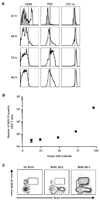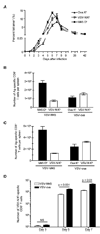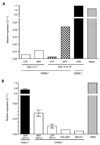Endogenous naive CD8+ T cell precursor frequency regulates primary and memory responses to infection
- PMID: 18499487
- PMCID: PMC2836785
- DOI: 10.1016/j.immuni.2008.04.010
Endogenous naive CD8+ T cell precursor frequency regulates primary and memory responses to infection
Abstract
Through genetic recombination, the adaptive immune system generates a diverse T cell repertoire allowing recognition of a vast spectrum of foreign antigens. Any given CD8+ T cell specificity is thought to be rare, but none have been directly quantified. Here, major histocompatibility complex tetramer and magnetic-bead technology were coupled to quantitate naive antigen-specific CD8+ T cells and the early response to infection. Among six specificities measured, the number of naive antigen-specific precursors ranged from approximately 80 to 1200 cells/mouse. After vesicular stomatitis virus infection, the antigen-specific CD8+ T cell response occurred in discrete phases: prolonged activation of a subset of cells over the first 72 hr followed by a rapid proliferative burst. Naive precursor frequency altered response kinetics and regulated immunodominance, as well as the time required for the responding population to shift toward CD62L(hi) memory cells. Thus, initial endogenous precursor frequencies were surprisingly diverse and not only regulated initial immune response characteristics but also controlled memory CD8+ T cell lineage decisions.
Figures







References
-
- Altman JD, Moss PAH, Goulder PJR, Barouch DH, McHeyzer-Williams MG, Bell JI, McMichael AJ, Davis MM. Phenotypic analysis of antigen-specific T lymphocytes. Science. 1996;274:94–96. - PubMed
-
- Bahl K, Kim SK, Calcagno C, Ghersi D, Puzone R, Celada F, Selin LK, Welsh RM. IFN-induced attrition of CD8 T cells in the presence or absence of cognate antigen during the early stages of viral infections. J. Immunol. 2006;176:4284–4295. - PubMed
-
- Barnes E, Ward SM, Kasprowicz VO, Dusheiko G, Klenerman P, Lucas M. Ultra-sensitive class I tetramer analysis reveals previously undetectable populations of antiviral CD8+ T cells. Eur. J. Immunol. 2004;34:1570–1577. - PubMed
Publication types
MeSH terms
Substances
Grants and funding
LinkOut - more resources
Full Text Sources
Other Literature Sources
Research Materials

